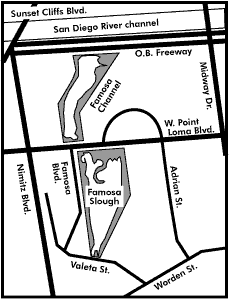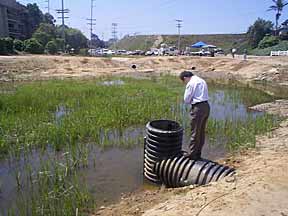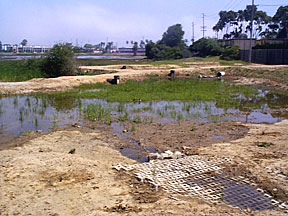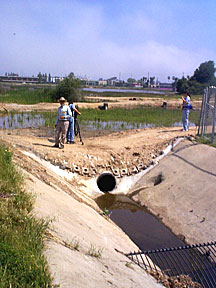Wetlands restoration leads the way at Famosa Slough
New pond system will help improve water quality and wildlife
habitat and show the way for Mission Bay.
by Jim Peugh
|
| |
  nce slated
for filling and paving, the Famosa Slough is continuing to be
a place where important lessons are being learned about accommodating
and working with nature in an urban setting. Famosa Slough is
a 30-acre wetland in the Loma Portal area of San Diego. Originally
part of the Mission Bay wetland complex, it was gradually isolated
from the bay and filled by development until citizens worked
to protect the remaining Slough from further encroachments and
establish it as wetland preserve. nce slated
for filling and paving, the Famosa Slough is continuing to be
a place where important lessons are being learned about accommodating
and working with nature in an urban setting. Famosa Slough is
a 30-acre wetland in the Loma Portal area of San Diego. Originally
part of the Mission Bay wetland complex, it was gradually isolated
from the bay and filled by development until citizens worked
to protect the remaining Slough from further encroachments and
establish it as wetland preserve.
 This
had led to the development of an Enhancement Plan to prevent
the degradation of the slough and lead to improved wetlands functioning
and to help treat urban storm drain runoff. This
had led to the development of an Enhancement Plan to prevent
the degradation of the slough and lead to improved wetlands functioning
and to help treat urban storm drain runoff.
 April 25 marked
the official dedication of an important model project. The San
Diego City Park and Recreation Department, in conjunction with
the Friends of Famosa Slough, finished the major construction
of three shallow ponds at the south end of the Slough. Runoff
from the neighborhoods is channelled into an existing concrete
pipe that empties into the Slough. The ponds have been constructed
at the end of the pipe to help slow and restore a more natural
flow into the Slough, which is connected to the San Diego river
channel. April 25 marked
the official dedication of an important model project. The San
Diego City Park and Recreation Department, in conjunction with
the Friends of Famosa Slough, finished the major construction
of three shallow ponds at the south end of the Slough. Runoff
from the neighborhoods is channelled into an existing concrete
pipe that empties into the Slough. The ponds have been constructed
at the end of the pipe to help slow and restore a more natural
flow into the Slough, which is connected to the San Diego river
channel.
 The ponds
project occupies about two acres of area that had been badly
degraded by the accumulated sediments and invasive vegetation
from many decades of neglect. The ponds
project occupies about two acres of area that had been badly
degraded by the accumulated sediments and invasive vegetation
from many decades of neglect.

The first of the three new ponds. Pipe provides overflow relief
from flooding. |
 In October
and November, volunteers for the Friends helped the Park Department
remove much of the nonnative vegetation from the project site.
The actual construction work started November 29 and was completed
at the end of March. In October
and November, volunteers for the Friends helped the Park Department
remove much of the nonnative vegetation from the project site.
The actual construction work started November 29 and was completed
at the end of March.
 The three
ponds are connected by adjustable pipes and overflow spillways
for big storms. The Friends have planted about 1,500 plants,
including many that they salvaged and others that were bought
or donated. They still have lots of planting and a number of
finishing touches to complete. The three
ponds are connected by adjustable pipes and overflow spillways
for big storms. The Friends have planted about 1,500 plants,
including many that they salvaged and others that were bought
or donated. They still have lots of planting and a number of
finishing touches to complete.
 The project
is designed to improve the quality of the urban runoff water
that flows into the south end of the Slough. The project will
also allow better viewing of the Slough from the south end, will
include a nature trail along some of the berms, will improve
habitat value, and will facilitate natural expansion of the salt
marsh habitat within the Slough. The project
is designed to improve the quality of the urban runoff water
that flows into the south end of the Slough. The project will
also allow better viewing of the Slough from the south end, will
include a nature trail along some of the berms, will improve
habitat value, and will facilitate natural expansion of the salt
marsh habitat within the Slough.
 It will be
an important project to watch for results that might be obtained
at other candidate restoration sites around Mission Bay: Rose
Creek, Tecolote Creek and Cudahy creek. All of these were concreted
over, as befitted the engineering approach of that era. Unfortunately,
that design only speeds the flow of pollutants into Mission Bay
and eliminates most habitat. Byron Wear, San Diego City Council
representative from the area, was on hand to congratulate the
Friends and others on their efforts. "The City is looking
forward to learning how this can be applied elsewhere,"
Wear commented. It will be
an important project to watch for results that might be obtained
at other candidate restoration sites around Mission Bay: Rose
Creek, Tecolote Creek and Cudahy creek. All of these were concreted
over, as befitted the engineering approach of that era. Unfortunately,
that design only speeds the flow of pollutants into Mission Bay
and eliminates most habitat. Byron Wear, San Diego City Council
representative from the area, was on hand to congratulate the
Friends and others on their efforts. "The City is looking
forward to learning how this can be applied elsewhere,"
Wear commented.
|
Treatment pond project overview
|
| |
 The
three ponds will treat urban runoff from about 100 acres of the
Slough's 300-acre watershed. It will intercept sediments, nutrients
from fertilizers and pet wastes, and contaminants from a variety
of sources. Managed ponds like these can be constructed in many
places to reduce or prevent chronic water quality problems. The
three ponds will treat urban runoff from about 100 acres of the
Slough's 300-acre watershed. It will intercept sediments, nutrients
from fertilizers and pet wastes, and contaminants from a variety
of sources. Managed ponds like these can be constructed in many
places to reduce or prevent chronic water quality problems.
 The ponds
are also intended to substantially improve the wildlife value
of the project area. They will provide an area of dense riparian
vegetation and freshwater marsh, and upland vegetation for a
broad range of birds and other wildlife. They will also provide
benign and safe access for wildlife viewing and education. The ponds
are also intended to substantially improve the wildlife value
of the project area. They will provide an area of dense riparian
vegetation and freshwater marsh, and upland vegetation for a
broad range of birds and other wildlife. They will also provide
benign and safe access for wildlife viewing and education.
 Over the next
three years, the plants will grow and the site will gradually
look less like a construction site and more and more like a diverse
riparian habitat. Over the next
three years, the plants will grow and the site will gradually
look less like a construction site and more and more like a diverse
riparian habitat.

Cement blocks in the foreground provide erosion control and
a transition between the new ponds. |
 From August
through November, the Friends and the Park Department removed
the larger vegetation from the site. Most of it was invasive,
such as Brazilian pepper, myoporum, and pampas grass. In November,
the contractor, Merkel & Associates, arrived with heavy equipment
and dug out the remaining vegetation, mainly Johnson grass, ice
plant and cattails. The Park Department removed it from the site
using their huge loaders and trucks. From August
through November, the Friends and the Park Department removed
the larger vegetation from the site. Most of it was invasive,
such as Brazilian pepper, myoporum, and pampas grass. In November,
the contractor, Merkel & Associates, arrived with heavy equipment
and dug out the remaining vegetation, mainly Johnson grass, ice
plant and cattails. The Park Department removed it from the site
using their huge loaders and trucks.
 The soft soil
of the Slough made construction difficult. Several pieces of
equipment got stuck, even though they were designed for tough
areas. The original plan was to use large equipment to push large
quantities of dirt from one area to another to form the ponds
and berms around them. It became clear that the big equipment
would just sink in the wet soil. Instead, the soil had to be
dug up with an excavator, reaching from a stable area, and carried
to its destination by special small bulldozers called Posi-Tracks.
The Posi-Track placed the soil to form the permanent berms or,
in many cases, temporary berms to support the excavator. Subsequently,
the excavator dug up the temporary berms and placed the soil
for the Posi-Track to move again. This was a pretty slow process,
and took a while to figure out. The soft soil
of the Slough made construction difficult. Several pieces of
equipment got stuck, even though they were designed for tough
areas. The original plan was to use large equipment to push large
quantities of dirt from one area to another to form the ponds
and berms around them. It became clear that the big equipment
would just sink in the wet soil. Instead, the soil had to be
dug up with an excavator, reaching from a stable area, and carried
to its destination by special small bulldozers called Posi-Tracks.
The Posi-Track placed the soil to form the permanent berms or,
in many cases, temporary berms to support the excavator. Subsequently,
the excavator dug up the temporary berms and placed the soil
for the Posi-Track to move again. This was a pretty slow process,
and took a while to figure out.
 When the soil
movement was complete, the major pipes were placed and the contours
of the berms and ponds were completed. Later, pipes between ponds
and the control structures were added to control the depths in
each pond. The erosion control mats were then installed at areas
where high levels of erosion could occur. When the soil
movement was complete, the major pipes were placed and the contours
of the berms and ponds were completed. Later, pipes between ponds
and the control structures were added to control the depths in
each pond. The erosion control mats were then installed at areas
where high levels of erosion could occur.
|
Revegetation of the treatment pond area
|
| |
 Merkel
& Associates drafted a Habitat Mitigation Plan to guide the
revegetation process. The plan emphasizes bulrush for the basin
bottoms. As a perennial, bulrush will do a better job of containing
contaminants than the annual cattails. The plan includes transition
plants for the lower portions of the banks, such as willows,
mulefat, saltgrass, spiny rush, San Diego marsh elder and California
rose. Merkel
& Associates drafted a Habitat Mitigation Plan to guide the
revegetation process. The plan emphasizes bulrush for the basin
bottoms. As a perennial, bulrush will do a better job of containing
contaminants than the annual cattails. The plan includes transition
plants for the lower portions of the banks, such as willows,
mulefat, saltgrass, spiny rush, San Diego marsh elder and California
rose.

Looking downstream into Famosa Slough toward the new treatment
ponds. |
 Revegetation
efforts actually began as the project started. As the contractors
removed bulrush from the site with an excavator, they stacked
it nearby. The Friends dug through the stacks and salvaged the
roots of the bulrush for eventual replanting. The Friends also
salvaged saltgrass from dug-up soil and took cuttings of willows
that were removed, rooting them for later replanting. Revegetation
efforts actually began as the project started. As the contractors
removed bulrush from the site with an excavator, they stacked
it nearby. The Friends dug through the stacks and salvaged the
roots of the bulrush for eventual replanting. The Friends also
salvaged saltgrass from dug-up soil and took cuttings of willows
that were removed, rooting them for later replanting.
 The upland
areas have been revegetated with the same species of plants that
the Friends have been placing along Famosa Boulevard, such as
lemonade berry, buckwheat, goldenbush and sagebrush. They will
also plant several riparian trees, including cottonwood and sycamore,
in the wetter upland areas. This great diversity of native plants
is selected to support a broad native wildlife community. Watering,
weeding and putting in more plants will be a major chore for
the next year, and volunteers are welcome. The upland
areas have been revegetated with the same species of plants that
the Friends have been placing along Famosa Boulevard, such as
lemonade berry, buckwheat, goldenbush and sagebrush. They will
also plant several riparian trees, including cottonwood and sycamore,
in the wetter upland areas. This great diversity of native plants
is selected to support a broad native wildlife community. Watering,
weeding and putting in more plants will be a major chore for
the next year, and volunteers are welcome.
|
Wildlife at the treatment ponds
|
| |
 The
new treatment ponds already have had some wildlife use. During
construction, willets, yellowlegs, snowy egrets and owls would
move in after each day's work, to see what morsels were revealed.
Now that the construction is over, the ponds are frequented by
blue-winged teal, mallards, willets, and many red-winged blackbirds. The
new treatment ponds already have had some wildlife use. During
construction, willets, yellowlegs, snowy egrets and owls would
move in after each day's work, to see what morsels were revealed.
Now that the construction is over, the ponds are frequented by
blue-winged teal, mallards, willets, and many red-winged blackbirds. |
Participants in the treatment pond project
|
 |
 The
design and engineering of the treatment ponds was contributed
by Project Design Consultants, a San Diego landscape architect
firm. The Armorloc blocks and A-Jacks (erosion control materials)
are being provided at cost by Erosion Technology, Inc., and Armortec.
The primary funding is from a $126,000 Clean Water Act, section
319(h) grant, which the Friends applied for and won. The grant
is administered by the San Diego Regional Water Quality Board.
The project is also supported by a $40,000 grant to the Friends
from the US Fish and Wildlife Service, a major contribution of
services from the City, a grant match between the Park Department
and the Friends for materials, and labor and funds from the Friends
for revegetation and berm stabilization. Merkel and Associates
did the construction for the City and is the consultant for the
Friends. Some of the plants for revegetation have been contributed
by Tree of Life Nursery, Merkel and Associates, and Walter Andersen
Nursery; others were purchased or salvaged by the Friends. The
design and engineering of the treatment ponds was contributed
by Project Design Consultants, a San Diego landscape architect
firm. The Armorloc blocks and A-Jacks (erosion control materials)
are being provided at cost by Erosion Technology, Inc., and Armortec.
The primary funding is from a $126,000 Clean Water Act, section
319(h) grant, which the Friends applied for and won. The grant
is administered by the San Diego Regional Water Quality Board.
The project is also supported by a $40,000 grant to the Friends
from the US Fish and Wildlife Service, a major contribution of
services from the City, a grant match between the Park Department
and the Friends for materials, and labor and funds from the Friends
for revegetation and berm stabilization. Merkel and Associates
did the construction for the City and is the consultant for the
Friends. Some of the plants for revegetation have been contributed
by Tree of Life Nursery, Merkel and Associates, and Walter Andersen
Nursery; others were purchased or salvaged by the Friends.
 Volunteers
from the Friends, along with groups from Point Loma Nazarene
University, Alpha Phi Omega at UCSD, CHiPS at Scripps Institute
of Oceanography/MPL, NCCC, Mesa College, Pt. Loma High School,
and Dana School, contributed lots of labor at many phases of
the project. Volunteers
from the Friends, along with groups from Point Loma Nazarene
University, Alpha Phi Omega at UCSD, CHiPS at Scripps Institute
of Oceanography/MPL, NCCC, Mesa College, Pt. Loma High School,
and Dana School, contributed lots of labor at many phases of
the project.
 The Friends
of Famosa Slough (FFS) is a nonprofit organization established
to protect and restore the Slough as a natural wetland preserve
and to promote public awareness of the importance of wetlands.
The Slough was purchased by the City of San Diego in September
1990 and is managed by the City's Park and Recreation Department. The Friends
of Famosa Slough (FFS) is a nonprofit organization established
to protect and restore the Slough as a natural wetland preserve
and to promote public awareness of the importance of wetlands.
The Slough was purchased by the City of San Diego in September
1990 and is managed by the City's Park and Recreation Department.

|
 Friends of Famosa Slough, PO Box 87280, San Diego, CA 92138-7280. Email: peugh Friends of Famosa Slough, PO Box 87280, San Diego, CA 92138-7280. Email: peugh home.com. For more information, call (619) 224-4591 or see the FFS website: groups.sandiegoinsider.com/ffs home.com. For more information, call (619) 224-4591 or see the FFS website: groups.sandiegoinsider.com/ffs |
![]()
![]()
![]()
![]()
![]()
![]()
![]()
![]()
![]()
![]()
![]()
![]()
![]()
![]()
